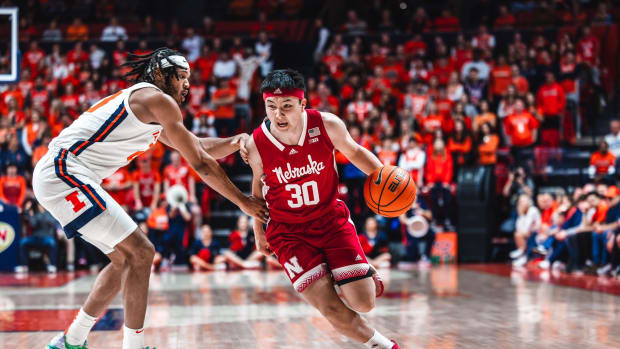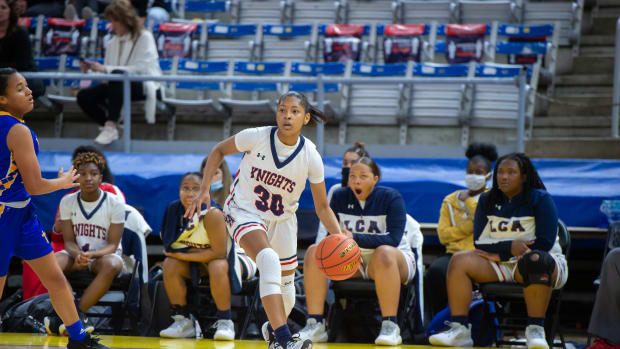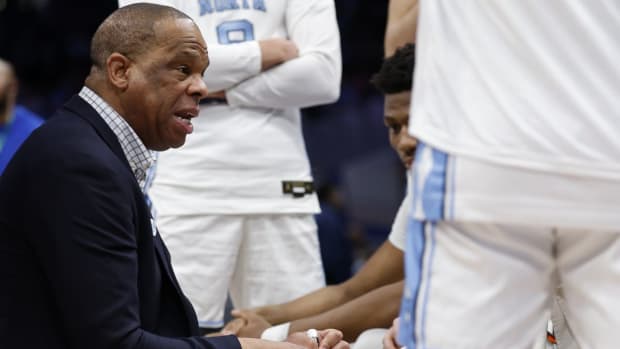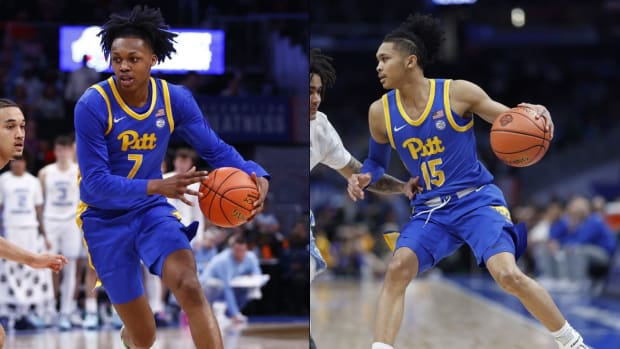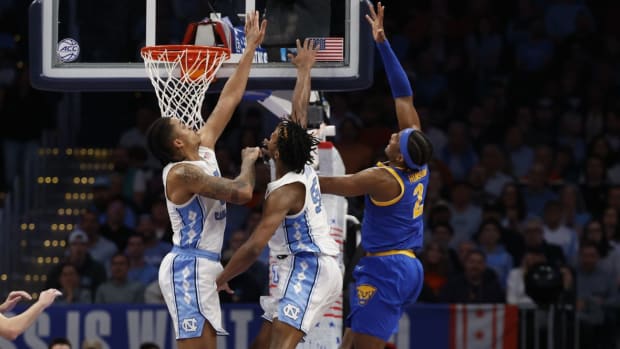A D-II freshman made 67% of his threes. Did he shoot enough for it to be a meaningful stat?
This, I assure you, is a basketball column, but the subject is so obscure that the widest television exposure he received, in 2017, was as a fan at a Kansas City Royals home game on April 14.
To set the scene: The Royals are up 7-1 on the Angels with two outs in the top of the ninth, but Peter Moylan, K.C.'s side-armed mop-up reliever, is struggling enough to make things interesting. He's got runners on first and second, and he's just fallen farther behind in the count, 3-1, to Andrelton Simmons. Fans in the seats behind home plate, in the background of the camera shot, are standing and halfheartedly cheering for Moylan to get this over with.
This is when one of the fans in the second row, near the center aisle—a tall and skinny young man making a questionable fashion decision—catches the eye of Fox Sports Kansas City play-by-play announcer Ryan Lefebvre. "Do you think Moylan's having any trouble," Lefebrve asks his color commentator, Rex Hudler, "with that guy behind home plate with his powder blue jersey unbuttoned, with no undershirt? That could be a bit of a distraction."
Hudler starts laughing. "You know, I didn't see him until now."
Lefebvre: "Umm … that’s … not helping our guy at all."
Hudler: "That's not a good look. But we're happy he's here."
The 2017 Effy Awards, Part II: Celebrating the best offensive players and teams
Moylan proceeds to load the bases with a walk. After he regains his control against the next batter, Cameron Maybin, and gets ahead in the count at 1-2, Hudler makes a declaration. "Pretty safe to say that Moylan's gonna get through the sight of that young fan there. He's into it."
They do not know who the young fan is. Nor should they be expected to. That unbuttoned, human distraction was the most valuable, small-sample shooter in all of American basketball this season—and he is anonymous to 99.9% of people who follow the sport.
****
An incomplete list of three-point stats from 2016-17 that double as macro evidence of the forward progress of the three-point revolution:
* NBA teams took the highest percentage of shots from beyond the arc (31.6%) in the league's history.
* NCAA Division I men's teams took the highest percentage of shots from beyond the arc (36.4%) in D-I history.
* NCAA D-II men's teams took the highest percentage of shots from beyond the arc (36.0%) in D-II history.
A three-point stat from this season that has less meaning, but made me want to find out if it's as crazy as it seems, and how it happened:
* The unbuttoned-jersey-wearing guy from the Royals game, Ryan Welty—a 6'7" freshman at D-II Northwest Missouri State—shot 66.7% from long range, albeit on just 78 attempts.
The 2017 Effy Awards, Part III: Celebrating the best defensive players and teams
This didn't become a national story because D-II hoops doesn't get much national coverage, and because Welty didn't qualify for the NCAA's official leaderboard, which requires a minimum of 2.5 made threes per game. Welty made just 1.4, due to him being an 18.2-minutes-per-game backup on a veteran team that went 35-1 and won the national title.
Welty's 78 attempts is a small sample, and way too small of a sample to anoint him the king of college three-point shooters. But it's not a nothing sample. If you're assuming somebody in D-I does this every few years—as in, shoots a ridiculous percentage from long range on a sub-qualifying number of attempts—you're mistaken. Sports-Reference.com has standard, D-I player stats going back to 1992-93, and during that time, just 12 players have shot better than 55% from three on a minimum of 50 attempts. The highest percentage belongs to Southern Illinois-Edwardsville's Kris Davis, who shot 59.8% from deep (58-for-97) as a freshman in 2011-12.
This means that at the highest level of college hoops—even going back to the era of the shorter three-point line—no one's broken 60% on a minimum of 50 attempts from '92-93 to the present. As for whether it's been done in D-II, the answer is … incomplete. A sortable database of historic, D-II stats isn't available, but according to the NCAA's official record book, these are the highest percentages recorded by leaderboard qualifiers since the three-point line went into place:
It looks like Welty would be No. 1, but the problem is that the goalposts were moved. In the early years of the three-point line, the NCAA seems to have only required two attempts per game to qualify for its national leaderboard, whereas now it requires 2.5 makes.
A third, but also incomplete, source available is Synergy Sports Technology, which has been tracking D-I comprehensively since 2009, as well as select D-II, D-III and even NAIA teams for the past few seasons. For some reason, Synergy only has leaderboards available for halfcourt three-point percentage leaders, but across its entire college database, there are just 15 players who shot better than 55% on at least 50 attempts, and only three who shot better than 60%. No one was better than Welty.
****
The obvious, unanswered question here: Why was Welty a reserve for a D-II team, and not a key cog of some super-efficient, D-I offense?
Welty did have some low-major, D-I offers coming out of Park Hill South High School in Parkville, Mo., where he was a 6'7", 180-pound forward who shot 47% from long range as a junior and 43% as a senior. He visited American, Central Arkansas and Denver, but, he says, "I wanted to go somewhere where we could win right away.” The D-I options were likely sub-.500 teams, whereas Northwest Missouri State looked like a national title contender—and went on to win it all.
"I was surprised that mid-majors didn't offer Ryan," says Northwest Missouri State coach Ben McCollum. "But that's the thing with a lot of my players—they don't quite pass the eye test. My point guard, Justin Pitts, was the D-II player of the year, but he's 5'9", and 145 pounds, so he doesn't necessarily look the part. Zach Schneider”—a senior power forward who made 46% of his threes on 235 attempts, and started in front of Welty—“can really shoot it, but he has a receding hairline and is a step slow. And Ryan Welty is 6'7" but skinny, so he looks like your next-door neighbor."
Arizona coach Sean Miller eyes Final Four breakthrough
Welty is the next-door neighbor who will destroy you in a game of HORSE. At Northwest Missouri State, he acted as a floor-spacing, catch-and-shoot option on passes out of their ballscreen-heavy offense, or as a pick-and-pop weapon. McCollum shortened the Bearcats' rotation during the final rounds of the D-II NCAA tournament, so Welty only played two minutes—and attempted just one three—in the title game that aired on CBS. But in December of this season, he had a streak of 16 straight three-point makes that stretched over three games, which was a surreal experience for someone who was four years removed from being a non-shooter.
In October of his freshman year of high school, Welty's father, Keith, took him and his older brother, Hudson, now an NAIA player, to be evaluated by a shot doctor in Kansas City named Bill Stutz. Stutz had been a shooter of some renown at D-II Slippery Rock in the late '70s and early '80s; one of his sons, Garrett, played center at Wichita State from 2008-’12; and Bill has a skill-instruction business called the Stutz Basketball Academy. The boys were promising players, but they had broken shots, and Stutz told them so.
"What do you want me to do?" Stutz asked Keith.
"I want you to fix them," he replied.
And so over the next few years—and somewhere between 200-250 hours of shooting instruction with Stutz—the Welty boys' shots underwent complete overhauls. Stutz says Ryan was so weak, at first, "that his shot was like someone trying to launch a medicine ball, bringing it all the way back over his right shoulder." They focused on a form where the feet align on "railroad tracks to the rim," and the armpit, elbow and wrist are all at 90-degree angles—or what Stutz calls "carrying the pizza," because it can look like a pizzeria server bringing out a fresh pie.
They tried to eliminate any of Welty's wasted movement between catch and shot—no tuck, no dip—and succeeded in halving his release time from the 1.0-1.2 second range, when he started, to the 0.5-0.6 range now. When they were finished, Welty's form bore some resemblance to one of the NBA's shooting stars. Not the Warriors' Stephen Curry, whom Stutz believes is a master of shooting the wrong way, but one of Curry's teammates. "You've seen Klay Thompson's shot—that's honestly, the most perfect form you can have, because he doesn't bring the ball down at all," Welty says. "So we tried to replicate that."
The biggest winners and losers from the NBA draft's early entry deadline
Thompson shot 41.4% from deep this regular season—on 647 attempts, more than eight times Welty's volume. He has played in three All-Star games and won an NBA title. He holds the NBA record for most points in a quarter, with 37 (including nine threes), and this season, he scored 60 points while playing just 29 minutes of a game against the Pacers. But Thompson never shot anywhere close to 66.7% from deep over an entire season of college basketball. In his best season at Washington State, as a freshman in 2008-09, he topped out at 41.2% on 165 attempts.
These facts afford Welty only the kind of bragging rights that are accompanied with a giant asterisk: not enough attempts to be conclusive evidence of greatness. He should be forgiven, though, for celebrating by purchasing an expensive Royals ticket behind home plate and possibly distracting a reliever due to his lack of an undershirt. Welty had just won a national championship and finished a season in which he drained 66.7% of his three-point tries. Regression is coming. The odds are overwhelming that even for the most flawless of shooters, breaking 60% will only happen once in a lifetime.





